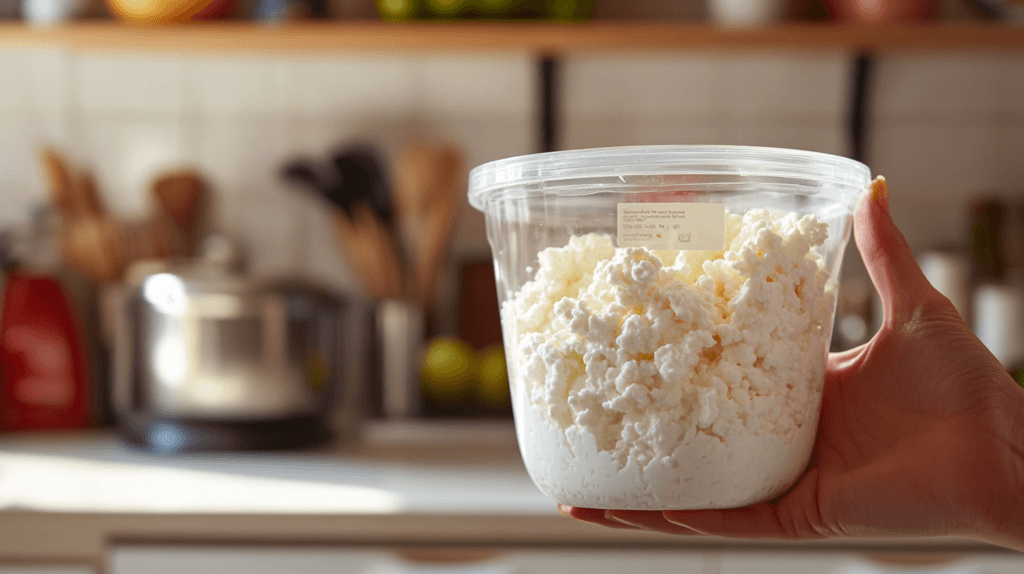Introduction
Cottage cheese is a versatile dairy item, celebrated for its creamy texture and subtle flavor. This article explores the ins and outs of freezing cottage cheese, from whether it’s safe to freeze, how to do it correctly, and what to expect in terms of texture and taste. We’ll also share tips on using frozen cottage cheese in recipes and suggest alternatives if freezing isn’t ideal for you.
What Is Cottage Cheese?
Cottage cheese is a fresh dairy product made by curdling milk and separating the curds from the whey. Its soft, lumpy texture and mild flavor make it a versatile ingredient in many cuisines around the world. Unlike aged cheeses, cottage cheese doesn’t go through a ripening process, which gives it its unique, fresh taste.
History and Popularity of Cottage Cheese
The origins of cottage cheese date back to ancient times when people first began curdling milk to preserve it. The name “cottage cheese” stems from its humble beginnings, as it was often made in rural cottages with leftover milk. Over the centuries, it has grown in popularity and is now a global favorite for its adaptability in recipes and health benefits.
Nutritional Value of Cottage Cheese
Cottage cheese is packed with essential nutrients, making it a staple for health-conscious individuals. A standard serving provides:
- Protein: A high-quality source that aids in muscle growth and repair.
- Calcium: Crucial for maintaining strong bones and teeth.
- Low Calories: Ideal for weight management, especially in low-fat varieties.
- Vitamins and Minerals: Includes B12, phosphorus, and selenium, all of which are vital for overall health.
Whether you enjoy it plain, mixed with fruits, or incorporated into recipes, cottage cheese is a versatile and nutritious option.
Is It Safe to Freeze Cottage Cheese?

Yes, it is safe to freeze cottage cheese. Freezing extends its shelf life and allows you to save any excess for future use. However, while the nutritional value remains intact, freezing can slightly alter the texture and consistency of the cheese.
Benefits of Freezing Cottage Cheese
Freezing cottage cheese offers several advantages, especially for those who buy in bulk or want to avoid waste:
- Extended Shelf Life: Fresh cottage cheese typically lasts about a week in the fridge. Freezing can preserve it for up to three months.
- Convenience: You can portion and freeze cottage cheese for easy access when cooking or baking.
- Cost-Effective: By freezing leftovers, you save money and reduce food waste.
Common Concerns About Freezing Cottage Cheese
While it offers many benefits, there are a few factors to consider:
- Texture Changes: Cottage cheese contains a lot of water, which can separate and crystallize during freezing. This may result in a grainy or watery texture once thawed.
- Best Uses Post-Freezing: Thawed cottage cheese may not be ideal for eating fresh on its own but works well in recipes like casseroles, pancakes, and smoothies.
Understanding these factors can help you decide if freezing is the right option for your needs.
How to Properly Freeze Cottage Cheese
Freezing cottage cheese is easy, but following the proper steps helps preserve its quality and usability. Proper preparation prevents freezer burn and reduces texture changes.
Step-by-Step Freezing Guide
- Check Freshness: Freeze only fresh cottage cheese that is within its expiration date. Freezing won’t improve the quality of cheese that is spoiled or nearing expiration.
- Stir Before Freezing: Mix the cottage cheese thoroughly to evenly distribute the curds and whey, ensuring a more consistent texture after thawing.
- Transfer to a Freezer-Safe Container:
- Use an airtight container or heavy-duty freezer bag.
- Avoid freezing in the original packaging, as it may not be airtight.
- Portion the Cheese: Separate the cottage cheese into small, convenient portions to avoid thawing and refreezing large quantities, which can reduce quality.
- Remove Excess Air: If using a freezer bag, squeeze out as much air as possible to prevent freezer burn.
- Label and Date: Write the freezing date on the container or bag to keep track of its storage time.
- Place in the Freezer: Store the container in the coldest part of the freezer to ensure rapid freezing and maintain quality.
Essential Tips for Freezing Cottage Cheese
- Consider the Fat Content: Full-fat cottage cheese freezes better than low-fat versions. The higher fat content helps preserve texture and flavor.
- Avoid Freezing Too Long: For the best results, consume frozen cottage cheese within three months. Beyond this period, quality may decline.
- Stir After Thawing: Stir thawed cottage cheese to mix the separated whey back into the curds.
Best Storage Containers for Freezing Cottage Cheese
The choice of container can have an impact:
- Airtight Plastic Containers: Sturdy and excellent for preventing air exposure.
- Freezer Bags: Space-saving and easy to label.
- Vacuum-Sealed Bags: Ideal for long-term storage and preserving freshness.
Thawing Cottage Cheese: What You Need to Know
Proper thawing is key to preserving the texture and usability of frozen cottage cheese. Using the right method ensures it remains safe to eat and suitable for recipes.
Methods for Thawing Cottage Cheese
- Refrigerator Thawing (Best Method)
- Place the frozen container of cottage cheese in the refrigerator.
- Allow it to thaw slowly overnight or for 8–12 hours, depending on the size of the container.
- This method minimizes texture changes and maintains food safety by keeping the cheese at a consistent, cold temperature.
- Cold Water Thawing
- Submerge the sealed container in cold water.
- Change the water every 30 minutes to ensure even thawing.
- This method is faster than refrigerator thawing, typically taking 2–3 hours, but the cheese should be used promptly afterward.
- Microwave Thawing (Not Recommended)
- If you’re in a rush, you can thaw cottage cheese using the microwave on the lowest defrost setting.
- Pause frequently to stir the cheese and prevent overheating.
- While quick, this method can result in uneven thawing and texture changes.
How Long Does Thawed Cottage Cheese Last?
Once thawed, cottage cheese should be consumed within 2–3 days. Always keep it refrigerated during this time. Avoid refreezing, as repeated freezing and thawing can severely degrade texture and safety.
Tips for Using Thawed Cottage Cheese
Use in Recipes: Thawed cottage cheese is best suited for cooking and baking, where texture changes are less noticeable.
Stir Before Use: After thawing, the whey may separate from the curds. Stir well to reincorporate the liquid.
Does Freezing Affect Cottage Cheese Texture and Taste?
Freezing can slightly alter the texture and taste of cottage cheese, but these changes don’t make it unusable. Understanding these effects will help you decide how best to use frozen and thawed cottage cheese.
Changes in Texture After Freezing
Cottage cheese has a high water content, which can crystallize during freezing. When thawed, this may result in:
- Graininess: The curds may lose their smooth texture and become crumbly.
- Whey Separation: A layer of watery liquid (whey) often separates from the curds. This is normal and can be stirred back in.
- Softening: The curds may feel softer or less firm after thawing.
While these changes may affect the experience of eating cottage cheese fresh, they’re less noticeable when the cheese is used in cooked or blended recipes.
Changes in Taste After Freezing
The taste of cottage cheese remains largely unchanged after freezing and thawing. However, some people may notice a slightly less fresh flavor due to the effects of freezing on the dairy’s natural enzymes. To enhance its flavor:
- Add fresh herbs, spices, or a drizzle of honey.
- Incorporate it into dishes with bold flavors that mask minor changes.
Best Uses for Frozen and Thawed Cottage Cheese
Thawed cottage cheese may not be ideal for eating plain, but it’s perfect for recipes where texture isn’t a priority. Consider these options:
- Blended Recipes: Smoothies, dips, or sauces.
- Baked Dishes: Lasagna, casseroles, or pancakes.
- Savory Spreads: Mix with herbs and seasonings for a creamy topping.
How to Tell If Cottage Cheese Is Still Good After Freezing
Freezing extends the shelf life of cottage cheese, but it’s essential to ensure it’s safe and suitable for consumption once thawed. Here are some tips to determine if your cottage cheese is still good:
1. Check the Smell
A fresh cottage cheese smell is mild and slightly tangy. After freezing and thawing, if you detect a sour, rancid, or unpleasant odor, it’s best to discard the product. A foul smell indicates spoilage or bacterial growth.
2. Inspect the Texture
Thawed cottage cheese may naturally have a slightly grainy or watery texture due to the separation of curds and whey. However, if it appears excessively clumpy, slimy, or discolored, it could be a sign of spoilage.
- Normal Changes: Minor separation or graininess.
- Spoiled Signs: Presence of a slimy layer or an unusual thickness that doesn’t improve with stirring.
3. Look for Mold or Discoloration
Mold is an obvious indicator that the cottage cheese is no longer safe to eat. It may appear as green, black, or blue spots. Any discoloration that looks off compared to the original appearance should prompt you to discard it.
4. Taste Test
If the smell and appearance seem fine but you’re unsure about the quality, take a small taste. Fresh cottage cheese has a mild, creamy flavor. A bitter, overly sour, or strange taste means it’s no longer good for use.
5. Consider the Time Frame
- Frozen Cottage Cheese: If stored in the freezer for over three months, it may still be safe to eat, but the quality may have significantly declined. Always check for the signs mentioned above.
- Thawed Cottage Cheese: Consume within 2–3 days after thawing. Beyond this period, the risk of spoilage increases.
6. Additional Tip: When in Doubt, Throw It Out
If you’re uncertain about the freshness or quality of your cottage cheese, it’s better to err on the side of caution and discard it. Consuming spoiled dairy can lead to foodborne illnesses.
Creative Recipes Using Frozen Cottage Cheese

Cottage Cheese Pancakes
Thawed cottage cheese works beautifully in pancake batter, adding a rich, creamy flavor. Simply blend it with eggs, flour, and a pinch of baking powder for fluffy, protein-packed pancakes.
Cottage Cheese Smoothies
For a nutritious breakfast or snack, blend thawed cottage cheese with your favorite fruits, a splash of milk, and a drizzle of honey. The result is a creamy, tangy smoothie that’s packed with protein.
Baked Dishes With Cottage Cheese
From lasagna to stuffed peppers, thawed cottage cheese can add moisture and richness to baked dishes. Combine it with spinach and seasonings for a delicious stuffing or layer it into casseroles for extra flavor.
Alternatives to Freezing Cottage Cheese
Refrigeration Tips for Longer Shelf Life
If freezing isn’t an option, consider these tips for extending the shelf life of refrigerated cottage cheese:
- Store in Airtight Containers: This prevents exposure to air and slows spoilage.
- Keep It Cold: Store it in the coldest part of the fridge, typically the back.
- Avoid Contamination: Always use a clean spoon when scooping out cottage cheese to prevent bacteria from spreading.
Preserving Cottage Cheese With Other Methods
Other preservation methods include:
- Vacuum Sealing: Removes air and prolongs freshness without freezing.
- Turning It Into Spreadable Cheese: Combine with herbs and freeze as a spread to reduce textural changes.
FAQs About Freezing Cottage Cheese
Can All Types of Cottage Cheese Be Frozen?
Yes, both full-fat and low-fat cottage cheese can be frozen. However, full-fat versions tend to retain their texture better after thawing due to the higher fat content. To learn about alternative freezing techniques, check out our guide on how to freeze leftover foods like rotisserie chicken.
How Long Can You Freeze Cottage Cheese?
Cottage cheese can be frozen for up to three months. After this period, the quality may decline, though it remains safe to eat if stored properly. For tips on optimal freezing methods, explore our article on can you freeze compote.
Can Frozen Cottage Cheese Be Used for Baking?
Absolutely! Frozen and thawed cottage cheese is perfect for baking as the texture changes are not noticeable in cooked dishes. If you enjoy baking, you might also like our Southern cornbread recipe for a hearty addition to your table.
Is It Better to Freeze Full-Fat or Low-Fat Cottage Cheese?
Full-fat cottage cheese generally freezes and thaws better than low-fat versions due to its creamier consistency.
Can Cottage Cheese Be Refrozen After Thawing?
It’s not recommended to refreeze cottage cheese after thawing. This can lead to significant texture degradation and potential food safety concerns.
Conclusion
Freezing cottage cheese is an excellent way to extend its shelf life and reduce food waste. While the process might slightly alter its texture and taste, proper freezing and thawing techniques can help preserve its nutritional value and usability. Thawed cottage cheese works wonderfully in recipes such as pancakes, smoothies, and baked dishes, making it a versatile ingredient even after freezing.
However, freezing may not be suitable for all uses, especially when you want to enjoy the cheese fresh. By following the tips outlined in this guide, you can make an informed decision about whether to freeze your cottage cheese or explore alternative storage methods. Remember, the key to success is proper preparation and storage, ensuring that your cottage cheese remains as fresh and flavorful as possible.
Looking for more meal ideas? Try our rockfish recipes or the ultimate peach crumble recipe for a sweet twist.

